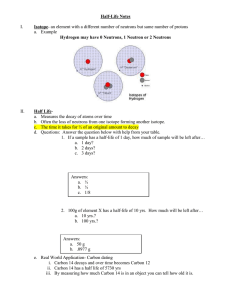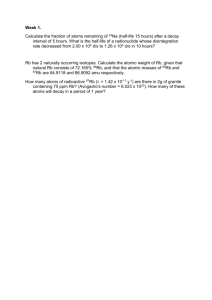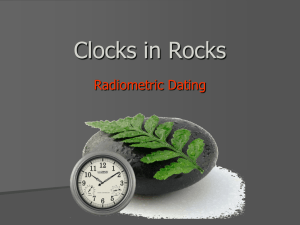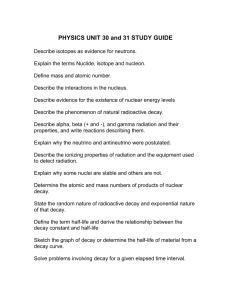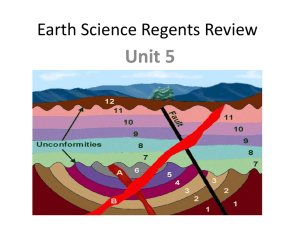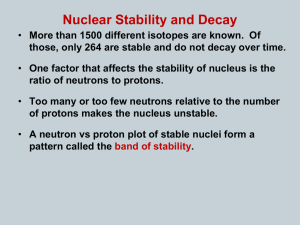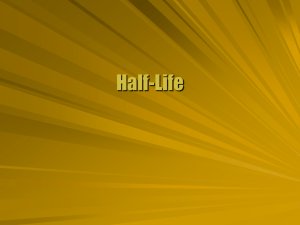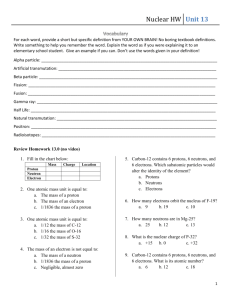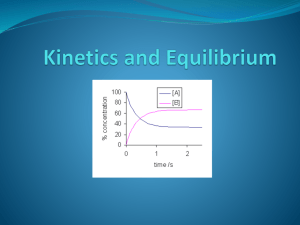Chem 311 Midterm Practice Problems
advertisement
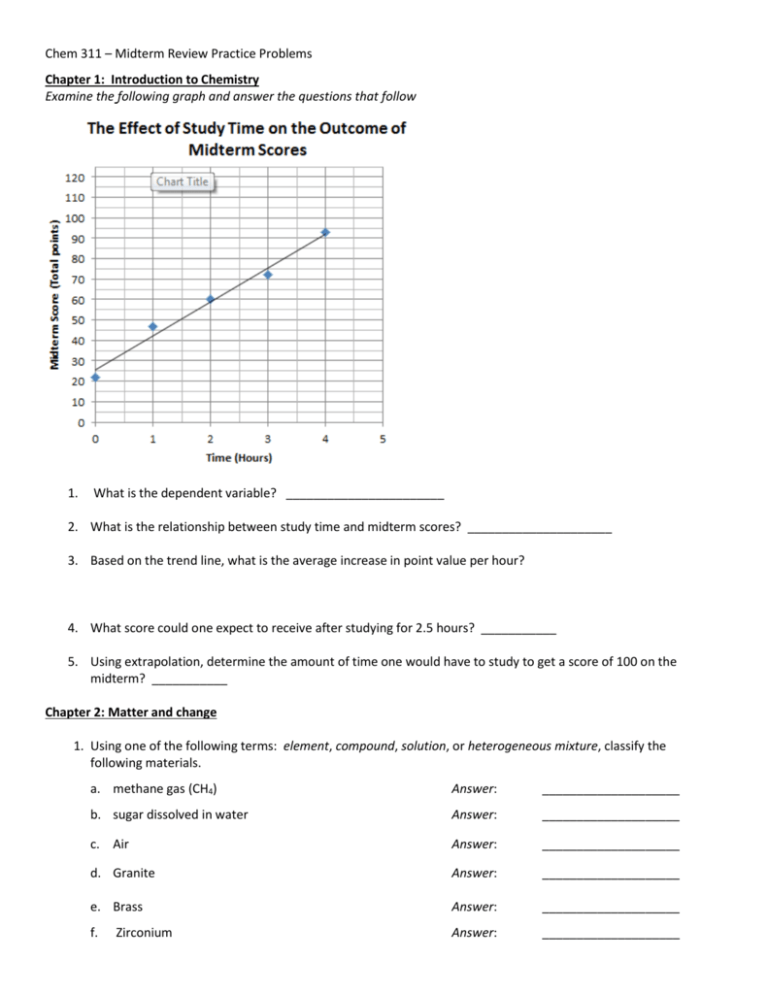
Chem 311 – Midterm Review Practice Problems Chapter 1: Introduction to Chemistry Examine the following graph and answer the questions that follow 1. What is the dependent variable? _______________________ 2. What is the relationship between study time and midterm scores? _____________________ 3. Based on the trend line, what is the average increase in point value per hour? 4. What score could one expect to receive after studying for 2.5 hours? ___________ 5. Using extrapolation, determine the amount of time one would have to study to get a score of 100 on the midterm? ___________ Chapter 2: Matter and change 1. Using one of the following terms: element, compound, solution, or heterogeneous mixture, classify the following materials. a. methane gas (CH4) Answer: ____________________ b. sugar dissolved in water Answer: ____________________ c. Air Answer: ____________________ d. Granite Answer: ____________________ e. Brass Answer: ____________________ f. Answer: ____________________ Zirconium 2. Determine whether the following properties are physical or chemical, and intensive or extensive by placing an “X” in the appropriate boxes. Property Density Conductivity Mass Color Physical Chemical Intensive Extensive 3. Determine whether the following processes represent physical or chemical changes by placing an “X” in the appropriate box. Process Physical Chemical Filtration Decomposition Change in color Crystallization 4. Determine whether the processes are endothermic or exothermic by placing an “X” in the appropriate box. Process Endothermic Exothermic Freezing of Bromine An explosion Boiling of water 5. Record the technique and property which would be used to separate the following mixtures Mixture Technique Property A solution of salt water (to yield salt crystals) A solution of alcohol and water Spaghetti in a pot of water Chapter 3: Scientific Measurement 1. How long is this nail? _____________ (each line represents 0.1 cm) 2. How many significant digits are there in the following measurements? 10.0600 cm ____ b. 0.00068050 pg ____ c. 653000 m ____ d. 1.860 x 1015 L ____ 3. Perform the following calculations and round your answers to the correct number of significant figures. (6.8 x 1023) (2 x 10-8) 1.05 x 104 + 9.8 x 103 4.32 x 10-4/6.5 x 10-12 4. Perform the following conversions using the factor label method. Report your answer in proper scientific notation with the correct number of sig figs. 1.0 kg = 2.2 lb 1.0 L = 34.0 oz 3 ft = 1 yd 1.6km = 1 mi 1.0 in = 2.54 cm 1.0 m = 1.13 yd 5280 ft = 1 mi 12 in = 1 ft a. How many yards are equal to 0.680 km? b. Answer: ____________________ Answer: ____________________ Answer: ____________________ How many picoliters are there in 0.00018oz c. Light travels at 3.00 x 108 m/s; what speed is that in mi/hr ? 5. What is the relationship between the following variables? Density and Mass ______________ Mass and Volume ______________ Density and Volume______________ 6. Calculate the volume of a gold brick in Liters with the dimensions of 3.5 cm x 5.0 cm x 23.2 cm. Gold has a density of 19.3g/ml. 7. What is the mass of chlorine gas that would fill a 250 ml jar at 25oC? The density of Cl2 at 25oC is 2.994 kg/m3. 8. A beaker is filled to the 250.0 mL line and then poured into a graduated cylinder. The cylinder, being a more precise instrument, shows that the volume is 243.50 mL. What is the percent error in the measurement using the beaker? (assume that the value recorded for the cylinder is your accepted value). Chapter 4: Atomic Structure 1. Complete the following table for the most common isotope Atomic Number Mass Number 8 Number of Protons Number of Neutrons 8 14 Number of Electrons 7 21 20 2. Atomic Mass The relative abundances of the isotopes of palladium are given below. Using this data calculate the average atomic mass of palladium. You will only be given credit if you show all your work. Follow all significant figure rules. Pd-102 Pd-104 Pd-105 Pd-106 Pd-107 Pd-110 101.9056 amu 103.9040 104.9051 105.9035 107.9039 109.9052 1.02 % 11.14 22.33 27.33 26.46 11.72 Answer: _____________ Chapter 25: Nuclear Chemistry 1. Write the following decay reactions: a. Alpha decay of Pu-250 b. Beta decay of Ca-45 c. Electron capture by S-28 d. Positron emission by Sc-41 2. Solve the following half-life problems. a. What is the half-life of Zr-110 if it takes 1.6 seconds for 120.0 g of the isotope to decay to 7.5 g? Answer: ____________________ b. How long would it take an isotope to decay from 3.0g to 0.75g if its half-life 3.24 x 106 years? Answer: ________________ c. What amount of a 40.2g sample of I-130 would remain after 12 years if it’s half-life is 18 months? Answer: ________________ 3. Refer to the band of stability graph to answer the following questions: a) Given the band of stability diagram, what type of decay would Zr-110 undergo? b) Write the equation for the decay of Zr-110 given your answer in (b) and circle the daughter nucleus in the equation. 4. Write the following induced transmutation reactions: a. Iron-60 undergoes alpha bombardment and produces two neutrons in addition to its daughter nuclide. b. Potassium-46 undergoes beta bombardment and produces three neutrons, chlorine-43 and what other particle? Chapter 5: Electrons in Atoms 1. Answer the following questions using the information given below. Be sure to report your answer in scientific notation. (7 pts) c = 3.00×108 m/s h = 6.626×10-34 Js E = hν 1 m = 1×109 nm c = λν a. What is the wavelength, in meters, of light with a frequency of 7.32×1019 Hz? Answer: ____________________ b. What is the energy of a photon of light with a frequency of 2.98×107 Hz? Answer: ____________________ c. Which of the two waves above has greater energy? Support your answer using either math or a written explanation. d. What is the relationship between: E and ν ____________ ____ λ and ν __________________ E and λ ____________________ 2. Answer the following questions regarding electron structure of the following elements ELEMENT Orbital Dot Diagram Noble Gas Electron Configuration [Ne] 3s23p3 Ho Too big to fit here Chapter 6 and 7.1: The Periodic and Ionic and Metallic Bonding 1. Fill in the following table with the correct information. Element Chemical Family Block Strontium Iodine Lead Chromium Berkelium Antimony Rubidium Sulfur Chapter 8: Covalent Bonding 1. Draw the structural formula for AsO33- (arsenite ion) What is it’s shape? Is it polar or non-polar? (if so, show the direction of polarity 2. Draw the structural formula for C2H5O2 (ethanoic acid) Is it polar or non-polar? (if so, show the direction of polarity) Lewis Dot Structure Most common ion

